.01″ rain fell at MSP Airport yesterday.
61 F. high temperature in the Twin Cities on Tuesday.
71 F. average high on May 23.
84 F. high on May 23, 2016.
May 24, 1925: After seeing a high of 99 degrees two days earlier, the Twin Cities picks up a tenth (.10) of an inch of snow.
May 24, 1908: Tornadoes hit the counties of Martin and Blue Earth.

Always Err On The Side of Caution: Rent the Tent
A friend asked me about the forecast for June 3, when 80 friends and family will gather in his yard for a bat mitzvah celebration. I told Adam the Twins would beat the Angels 6 to 4. The NASDAQ will have just closed 14 points higher. And June 3 will be warm & steamy with heavy T-storms nearby. Uh huh.
Confidence levels are low this far out, but my advice for anyone planning a grad party or outdoor wedding hasn’t changed. Rent. The. Tent. If you don’t you’re DARING Mother Nature to rain on your parade.
Remember, the weather owes us no favors.
The emerging pattern leads me to believe this will NOT be a stinking-hot summer. If anything I see a wet bias with temperatures at or below average. We’ll see.
The sun returns today, but a nagging atmospheric holding pattern keeps a T-shower risk going over the holiday weekend. Right now the best outdoor days look like Friday and Saturday, with some sun and highs in the low 70s. Afternoon instability showers blossom Sunday & Memorial Day with highs in the 60s as a cold storm in the upper atmosphere keeps our skies unsettled.
Not disastrous but hardly postcard-perfect either. It’s a holiday, keep your expectations low.
Forecasters Agree: This Summer to be “Substantially Cooler” Than Last Summer in D.C. My hunch: temperatures at or slightly below average during meteorological summer for Minnesota and Wisconsin, based on how the pattern seems to be shaping up. Here’s an excerpt from Capital Weather Gang: “…Comparing forecasts for this summer versus last summer, it’s substantially cooler,” said Stephen Baxter, lead author of the National Weather Service’s summer outlook. But, even if it not as hot as last summer, it’s still predicted to be plenty toasty — which is the emerging new normal. If it weren’t for climate change, the National Weather Service might be predicting a cooler than normal summer in Washington. Baxter said its prediction for a somewhat warmer than normal summer was made largely on the basis that summer temperatures are trending hotter in recent decades. “It’s a fairly overwhelming signal,” he said. The rising temperatures serve as “the backdrop” for the Weather Service’s warm summer forecast not just in Washington but for much of the East Coast, the South and the West...”
Map credit: “National Weather Service summer temperature outlook.” (Climate.gov).
May 8 Denver Hailstorm Was Colorado’s Costliest On Record. The Denver Post has details on the very costly hailstorm earlier this month: “…At $1.4 billion, the storm will surpass the $1.1 billion in damage claims, adjusted for inflation, that a storm on July 11, 1990, generated and the $845.5 million in claims tied to a storm on July 20, 2009. It will also be three times more expensive than the state’s most damaging wildfire, which destroyed 346 homes in the Waldo Canyon area of Colorado Springs in June 2012 and generated $453.7 million in payouts at the time. “The enormous size of the hail hitting densely populated areas of the Denver metro (area) during rush hour has contributed to the magnitude of damage caused by this storm,” Walker said...”
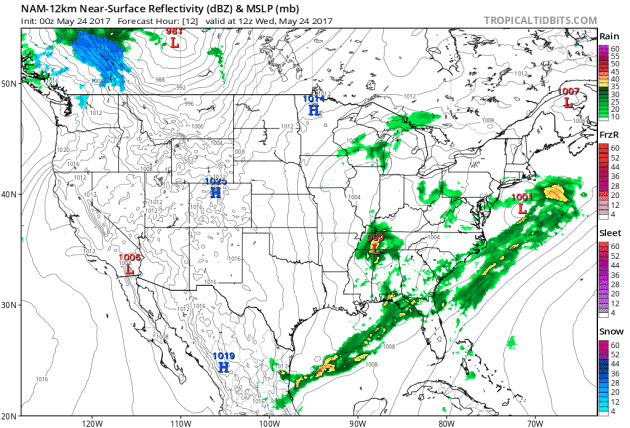
Sloppy Swirl. Models push heavy showers and T-storms across the Ohio Valley and Carolinas into the Mid Atlantic later today, reaching New England by Thursday – skies may clear by the weekend. The central USA dries out and the west remain relatively quiet and seasonably warm. No more snowstorms brewing for Colorado, for a chance. NAM Future Radar: NOAA and Tropicaltidbits.com.

Heaviest Rains East of the Mississippi. Here’s a look out 84 hours (NAM model) showing 1-2″ rains predicted for much of Florida and parts of the Midwest and Ohio Valley. Chicago, Louisville and Jacksonville may all see enough rain for (minor) flooding issues.
Trending Milder. Friday still appears to be the mildest day in sight (mid-70s if the sun is out for any length of time). Temperatures start to cool off slightly Sunday as a northwest wind kicks in, and we probably won’t climb out of the 60s on Memorial Day, according to ECMWF guidance. Source: WeatherBell.
Creeping Into Summer. With the exception of the Pacific Northwest much of the USA is forecast to be seasonably warm (hot for the southern and eastern states) within 2 weeks. I’m looking forward to people complaining about the heat, not the unusual late-season chill (and slush).
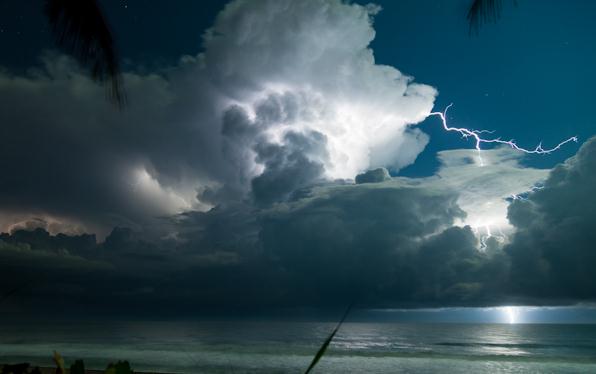
Thunderstorm Asthma Presents New Risks. I honestly don’t remember hearing about this 5, 10, 20 years ago. Not sure why it seems to be getting worse now, but WGAL-TV has details on this baffling phenomenon: “A phenomenon caused by thunderstorms has killed people in several countries, and it has nothing to do with lightning. Thunderstorm asthma is caused by dynamic airflow during strong storms, experts say. Violent winds sweep up allergens, such as pollen, creating tinier particles. While larger pollen grains are usually filtered by hairs in the nose, the smaller pollen fragments can pass through and enter the lungs, triggering asthma attacks, sometimes in people who have never suffered from asthma before. Thunderstorm asthma typically happens when a storm hits while pollen levels are excessively high, experts say...”
Tornado Test: Meet TWIRL and the Tools of Tornado Research. Why do some supercells go on to spawn EF-4 killers, while nearly identical thunderstorms do not? That goes to the heart of “TWIRL” research, as described by KHQA.com: “…The US sees hundreds of rotating storms called supercells every year. It’s these storms that can lead to tornadoes. But a strong storm does not always cause a strong tornado. “We need to understand why the most threatening looking supercells don’t make tornadoes, and why even more of those threatening looking supercells make weak tornadoes, insignificant tornadoes,” said meteorologist and tornado researcher Joshua Wurman, who is president of CSWR. “A lot of tornadoes really aren’t damaging or life threatening. But a few of these supercells do have that potential to make damaging, large tornadoes that can destroy homes and can hurt and kill people…”
Image credit: “The Doppler on Wheels (DOW) scans a severe thunderstorm in eastern Colorado while a Scout vehicle equipped with tornado pods waits instruction.”
Can Tornadoes Hit Downtowns? Yes. Tornadoes feed on warm moist air and twisting winds within a 10-20 mile radius. A few high rise buildings and some concrete won’t deter them from forming. Twisters have touched down in major cities from Chicago and Dallas to Salt Lake City. Oklahoma City has been hit over 140 times since 1890. On May 22, 2011 a powerful tornado with winds up to 110 mph tracked 14 miles into North Minneapolis; the funnel nearly half a mile wide at one point.
Thumbnails above courtesy of the Twin Cities National Weather Service, which has more information on the May 22, 2011 North Minneapolis tornado here.
List of Cities Striking Downtown Areas of Large Cities. Wikiwand.com has a long list of cities that have been struck: “…It is a common myth that tornadoes do not strike downtown areas. The odds are much lower due to the small areas covered, but paths can go anywhere, including over downtown areas. St. Louis, Missouri has taken a direct hit four times in less than a century.[1] Many of the tornadoes listed were extremely destructive or caused numerous casualties, and the occurrence of a catastrophic event somewhere is inevitable.[2] This list is not exhaustive (listing every single tornado that has struck a downtown area or central business district of any city), as it may never be known if a tornado struck a downtown area, or if it was just a microburst (powerful downward and outward gush of wind, which cause damage from straight-line winds), particularly for older events or from areas with limited information. Downbursts often accompany intense tornadoes, extending damage across a wider area than the tornado path. When a tornado strikes a city, it is occasionally very difficult to determine whether it was a tornadic event at all or if the affected area was indeed the “downtown”, “city centre”, or “central business district” consisting of very high population density and mid to high-rises, as opposed to other heavily urbanized/built-up parts of the city or suburbs…”
Joplin’s Recovery By The Numbers. In the movie “Twister” there is a reference to an F-5 tornado being “the finger of God”. Exhibit A: Joplin, Missouri. Here’s an excerpt from Missourian: “Six years after an EF5 tornado caused $2.8 billion worth of damage, the city of Joplin continues its steady recovery. The costliest tornado in U.S. history killed 161 people and injured more than one thousand on May 22, 2011. Much has changed since that day, which forced the city to restart. One of the significant impacts tornadoes have is on the the people of the cities it destroys. Joplin was no different, and its population suffered a dramatic drop because of the tornado. While it’s difficult to estimate exactly how many residents left the city in the immediate aftermath of the storm, the city underwent a dramatic downsize. Between 2011 and 2012, the city’s population fell 1.8 percent to 50,244, according to data from the U.S. Census Bureau...”
Photo credit: Kristan Lieb – Missourian File Photo. “An area of the city of Joplin lies in shambles on May 24, 2011, after an EF5 tornado flattened a mile-long swath of Joplin and killed 161 people two days earlier.”
Remembering Joplin. The wedge tornado that struck Joplin, Missouri on May 22, 2011 was a reminder of the limitations of technology. Here are a few of the take-aways from NOAA: “…This was the single deadliest tornado in U.S. history since modern record-keeping began in 1950. Rated EF-5 on the Enhanced Fujita scale, this mile-wide tornado was the largest and most powerful type, and it traveled 22 miles on the ground. The report includes a number of key recommendations:
- Improve warning communications to convey a sense of urgency for extreme events. This will compel people to take immediate life-saving action;
- Collaborate with partners who communicate weather warnings to develop GPS-based warning communications, including the use of text messaging, smart phone apps, mobile communications technologies, in addition to upgrades to the Emergency Alert System and NOAA Weather Radio;
- Collaborate more throughout the weather enterprise to ensure that weather warning messages sent via television, radio, NOAA Weather Radio, local warning systems such as sirens – are consistent to reduce confusion and stress the seriousness of the threat; and
- Continue to increase community preparedness...”
Photo credit: “Image showing damage from the tornado that hit Joplin, Mo., on May 22, 2011.” NOAA.
The May 22, 2011 Joplin, Missouri EF-5 Tornado. U.S. Tornadoes has a good recap of an extraordinary tornado: “...St. John’s Hospital was severely damaged — 200 to 300 pound parking stops were lifted and tossed 30 to 60 yards. Large steel reinforced concrete steps outside of a medical art building were shifted a few inches and cracked. Concrete walls toppled and steel support beams from some buildings were curved and twisted. EF-3 to low end EF-5 damage continued to just east of Rangeline Road as the tornado approached the Dusquesne area. At full strength, the tornado crushed homes and swept them from their foundations. Steel reinforced concrete porches and driveways were lifted and tossed. Vehicles were tossed into other homes or in some cases rolled up and crushed completely. This type of damage was found the along the rest of the track to just east of Rangeline Road. Along the track, boards, limbs and twigs were embedded into wood and stucco walls and wooded framed homes were completely disintegrated…”
Image credit: “Radar image showing the tornado as it exits Joplin. A debris ball is present in the top left corner image in pink. Radar image was taken around 7pm ET.”
Did Someone Predict the Recent Wisconsin Tornado? Meteorologists can tell when atmospheric conditions are ripe for tornadic storms, but we still can’t pin down where individual thunderstorms will spin up funnels more than 20-30 minutes in advance. Here’s an excerpt from Madison.com: “We cannot yet forecast tornado occurrence with any accuracy. One problem is the small size of a tornado, which is a narrow column of strong winds that rotate around a center of low pressure. Over the last 60 years, forecasts of the development of large-scale low-pressure systems, which often organize the ingredients needed to form a tornado, have steadily improved. Because of these advances, meteorologists are better able to predict those conditions a few days in advance, enabling forecasters to identify counties where there is a threat of severe weather sometimes as many as three days in advance. Two days in advance of the recent EF-2 tornado that hit southeastern Polk County, the National Weather Service’s Storm Prediction Center’s convective outlook issued a slight-risk for the area…”
Navy is Preparing for Hurricane Season with 2-Week Storm Simulation. Yes, the Navy pays very close attention to tropical systems, for good reason, according to Military.com: “…With thousands of personnel and billions of dollars in aircraft, ships and infrastructure scattered along the East Coast, including here, the Navy relies on real-time weather information to keep its sailors and resources safe. Though Brady wasn’t real, hurricane season is, and it starts June 1. To prepare, Navy commands throughout the mid-Atlantic and Southeast are in the midst of a two-week annual simulation in which one storm strikes the Gulf of Mexico and another hits the East Coast. “It’s out there to exercise all of the emergency action plans that we have at the different bases to make sure that the actions that we do take are the correct ones for the safety of our people and our resources,” said Lt. Cynthia Williamson, the Fleet Weather Center’s tropical operations officer...”
Photo credit: “Naval Air Station Pensacola Air Ops personnel remove cargo straps on one of several pallets of belongings to Hurricane Matthew evacuees from Guantanamo Bay, Oct. 2, 2016.” (U.S. Navy photo/Cathy Whitney)
The Day a Geomagnetic Storm Almost Started World War III. Dr. Marshall Shepherd explains how the world dodged a bullet in a piece at Forbes: “…NORAD’s Solar Forecast Center in Colorado Springs issued a warning, that a significant worldwide geomagnetic storm would occur within the next 36-48 hour. It seems that this alert was passed to the highest levels of government, but not to local commands. May 23, the geostorm disrupted the radars at all three stations of the Ballistic Missile Early Warning System, located in Cape Cod Air Force Station (Massachusetts), Beale Air Force Base (California) and Clear Air Force Station (Alaska). Local commanders of the airfields, considering a possible Soviet attack, ordered nuclear weapons ready to launch. As all stations were being jammed at the same time and during daylight, researchers at NORAD realized that not Soviets, but the sun was interfering with the radar stations. Information made it to commanders in time to stop the airplanes, but the military realized, even more, the importance to monitor space weather...”
Graphic credit: “Artist’s rendition of Earth’s magnetosphere.” Source Wikipedia, image in public domain.
Get Ready for Peak Oil Demand. A story at The Wall Street Journal captured my attention: “The world’s largest oil companies are girding for the biggest shift in energy consumption since the Industrial Revolution: After decades of growth, global demand for oil is poised to peak and fall in the coming years. New technologies that improve fuel efficiency are starting to push down the amount of gasoline and diesel that’s needed for transportation, and a consensus is growing that fuel demand for passenger cars could fall as carbon rules go into effect, electric vehicles gain traction and the internal combustion engine gets re-engineered to be dramatically more efficient. Western countries’ growth used to move in lockstep with their energy consumption, but that phenomenon is starting to decouple in advanced economies…”
Photo credit: “Some oil companies are talking publicly about peak oil demand and preparing for it by overhauling their long-term investment plans.” Andrey Rudakov/Bloomberg News.
Ford Replacing CEO Mark Fields Doesn’t Clarify Its Hazy Future. The auto industry is in the midst of significant disruption, a move from fossil fuels to electric, ride-sharing and autonomous vehicles that drive themselves. Who will the new winners and losers be in this brave new world? Here’s an excerpt from WIRED.com: “…But almost 10 years after the financial collapse that hobbled Detroit’s Big Three, Ford and other automotive giants face another potential crisis moment. The market is undergoing a radical shift away from selling private, gas-powered cars at dealerships, and toward more shared services and newer technology. For manufacturers accustomed to taking up to eight years to plan, design, build, and market a product, it’s an unnerving transition. In response, Ford’s crosstown rival General Motors has teamed up with Lyft, and Fiat-Chrysler is providing vehicles for Google’s Waymo, as automakers desperately try to lock in the right partner and the right technology for ridesharing, autonomous cars, and other mobility services they assume will be a part of the future transportation landscape…”
Photo credit: “Bill Ford Jr., right, executive chairman of Ford Motor Company, introduces Jim Hackett as CEO on Monday, May 22, 2017.” Paul Sancya/AP.
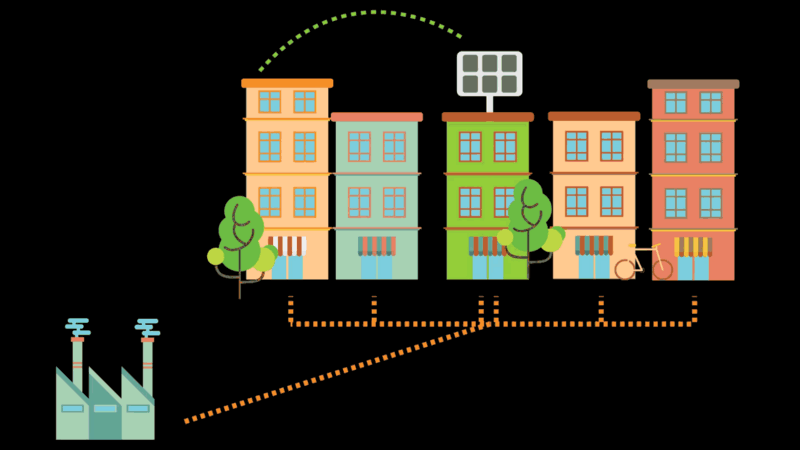
Large or Small, Cities’ 100% Renewable Energy Pledges Are More Than Symbolic. Why are people going green? Concern over climate change may be part of the incentive but in the end it’s about saving money and become more independent and self-reliant. Here’s an excerpt from Southeast Energy News: “It goes without saying that Atlanta, Georgia and Abita Springs, Louisiana are dramatically different places. As of this month, however, the two have something in common: they are some of the first Southeastern cities to commit to 100 percent renewable energy. Atlanta has a Democratic mayor and a fairly progressive city council; Abita Springs leans older and more conservative with a Republican mayor. But for both places, the decision was more about economic development than climate change. And in order for these goals to be more than symbolic, utilities and cities must change how they run – especially in a place as large as Atlanta…”
Photo credit: Abita Springs, Louisiana.
First Drive: 2018 Karma Revero. A worthy competitor to Tesla? Here’s an excerpt of a review at Automobile Magazine: “…The Revero retains the Karma’s original powertrain, a combination of twin electric motors mated to a 2.0-liter turbo-four that can serve as a parallel power source or range extender. Outputs are the same as well: a combined 403 hp and 981 lb-ft for the motors and 235 hp for the engine (Karma did not specify an engine torque figure). Battery-only range remains at around 50 miles, and charging still takes about 10 hours at 16 amps and six hours at 32 amps, but the car now comes with support for DC quick-charging as well. This can get the batteries back up to 80 percent (40 miles) in 24 minutes. Additionally, the solar roof also now charges the battery, though it can only provide around three miles of extra range over the course of day…”
Supersize My Hamburger Please. The world’s largest (commercially available) hamburger? Atlas Obscura explains where to track it down. Bring some friends: “…This massive meaty creation, aptly named the “Absolutely Ridiculous Burger,” holds the Guinness record for the world’s largest commercially sold hamburger, and it can be all yours for just $399. The typical Absolutely Ridiculous Burger weighs in at 150 pounds, with the official record-setter massing in at an even more whopping 338.6 pounds, double the weight of an average-sized human. The burger is so big that it takes 22 hours to make, three people to flip it over, and 100 pounds of excess grease to perfect. It’s so colossal that on an episode of Man Vs. Food, a team of 41 people couldn’t conquer the thing in a whole two hours of time...”
Image credit: Guinness World Records.
“Success is something you attract by the person you become.” — Jim Rohn
TODAY: Partly sunny, a nicer day. Winds: NE 7-12. High: 64
WEDNESDAY NIGHT: Mostly clear and cool. Low: 48
THURSDAY: Sunny start, late-day shower possible. Winds: SE 7-12. High: 71
FRIDAY: Decent lake day. Intervals of sun. Winds: W 8-13. Wake-up: 56. High: 75
SATURDAY: Lukewarm sun, late-day T-shower risk. Winds: NW 10-15. Wake-up: 58. High: 73
SUNDAY: More clouds, more numerous showers PM hours. Winds: NW 10-15. Wake-up: 53. High: 68
MEMORIAL DAY: AM sun, risk of a PM shower or two. Winds: NW 10-15. Wake-up: 55. High: 69
TUESDAY: Mostly cloudy, still cooler than average. Winds: NW 8-13. Wake-up: 51. High: 67
Climate Stories…
Photo credit: Brian Peterson, Star Tribune. “The forest north of Park Rapids, Minnesota, is a mix of aspen, birch and conifers.”
“Put Up or Shut Up”. WRAL’s Greg Fishel Goes Off on Climate Change Deniers. Greg is Chief Meteorologist at WRAL, and my oldest friend (we were resident weather-nerds in our high school and went on to attend Penn State at roughly the same time). Greg is brilliant and a terrific communicator, and he doesn’t suffer fools gladly. Here’s an excerpt from News & Observer: “Popular local weatherman Greg Fishel had strong words for climate change deniers on his Facebook page on Sunday. Fishel, chief meteorologist at WRAL, went off on people who question the science behind climate change, telling them to “put up or shut up.” The post had earned more than 3,500 reactions by Monday afternoon. “You know everybody reaches their breaking point and quite frankly I have reached mine with the folks who post all over the internet about the scientific fallacies of man induced climate change,” Fishel wrote. “All of them are guest bloggers or essayists. None of this stuff has ever been published in a peer reviewed atmospheric science or climate journal. But we live in an age today where higher education and research are no longer respected. Heck, think of all the money my parents wasted on my education when I could have waited for the age of twitter and Facebook and declared myself as an expert in the field of my choice…”
NATO Lawmakers Warn Climate Change May Worsen Middle East Security Risks. Reuters has the story: “Climate change will worsen food and water shortages in the Middle East and north Africa, and risk triggering more conflict and mass migration, with serious implications for the wider world, lawmakers from NATO’s Parliamentary Assembly said Monday. “The long-term prospects for food and water security in the MENA region are dire,” said Osman Askin Bak, a member of the Turkish Parliament who will present the draft report on Saturday at the Parliamentary Assembly – a gathering of senior parliamentarians from the North Atlantic Treaty Organization’s 28 member states. “Climate change will worsen the region’s outlook,” he added…” (File image: NASA MODIS).
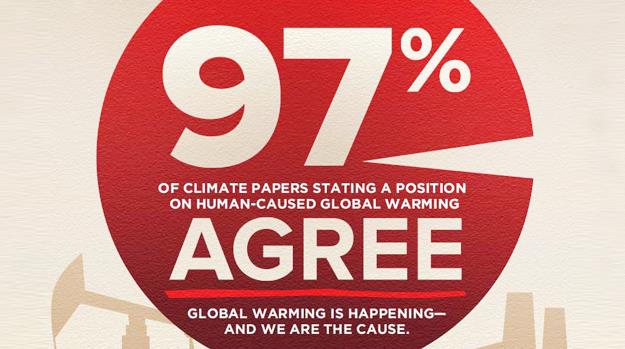
Why Scientific Consensus is Worth Taking Seriously. Here’s a clip from Bloomberg View: “Following the pack is not part of the scientific method. The point is to follow the evidence. And that leaves room for ambiguity in interpreting the survey results showing that 97 percent of climate scientists agree that global warming is real and that human-generated greenhouse gases are a major cause. The National Academy of Sciences, American Physical Society, American Chemical Society and other relevant scientific organizations all agree, too. For some, this consensus proves that climate change is real and that humans must take immediate action against it. But others, citing history, say the consensus view has been wrong before. Why should we believe it now? For example, scientists once believe the earth was headed into an ice age. So why should we trust them when they say the globe is warming?…”
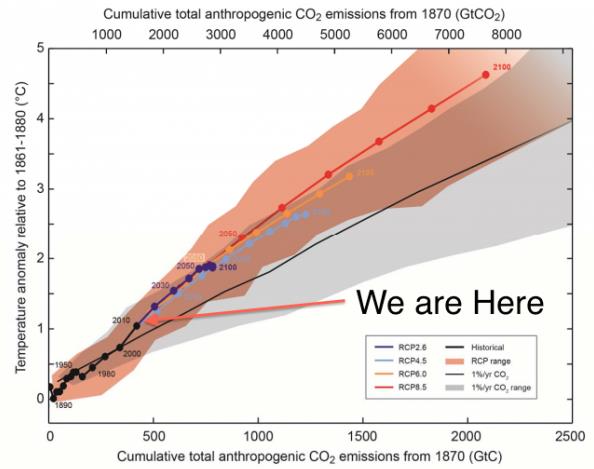
Scientists Say the Pace of Sea Level Rise Has Nearly Tripled Since 1990. Chris Mooney reports for The Washington Post: “A new scientific analysis finds that the Earth’s oceans are rising nearly three times as rapidly as they were throughout most of the 20th century, one of the strongest indications yet that a much feared trend of not just sea level rise, but its acceleration, is now underway. “We have a much stronger acceleration in sea level rise than formerly thought,” said Sönke Dangendorf, a researcher with the University of Siegen in Germany who led the study along with scientists at institutions in Spain, France, Norway and the Netherlands. Their paper, just out in the Proceedings of the National Academy of Sciences, isn’t the first to find that the rate of rising seas is itself increasing — but it finds a bigger rate of increase than in past studies. The new paper concludes that before 1990, oceans were rising at about 1.1 millimeters per year, or just 0.43 inches per decade. From 1993 through 2012, though, it finds that they rose at 3.1 millimeters per year, or 1.22 inches per decade...”
File photo: Skeptical Science.

How the GOP is Slowly Going Green. I may be in a minority, but I happen to agree. Axios has a hopeful story; here’s a snippet: “…Since 2010, climate change has been an issue unilaterally pushed by the Democratic Party, but for any climate and energy policy to pass Congress, it must also get support from within the GOP ranks. The changes among Republicans are small, but represent a sea change from a few years ago when under pressure from conservative interest groups and tea-party activism, most Republicans denied the scientific consensus that human activity is driving up the Earth’s temperature. “Tectonic plates beneath the Republican party are not stable,” said Jerry Taylor, who in 2014 founded the Niskanen Center, a conservative group that supports a carbon tax to address climate change. “That’s not obvious to anyone who is not engaging with Republicans on climate, but it’s fairly obvious to us...”
A Conservative Answer on Climate Change. Here’s an excerpt of an Op-Ed at The Pittsburgh Post-Gazette: “…Our conservative plan would attack pollution the way that Milton Friedman, a captain of modern conservatism, told us to attack it years ago: Tax it. A carbon tax would attach the cost of pollution to products so that the marketplace could see and rightly judge all of the costs of those products — the costs that the producer’s marketing department would let us see and the costs that they’d rather secretly slough off to the suckers who have to breathe their soot. If those costs were internalized on a level playing field, unsubsidized clean energy would beat unsubsidized dirty energy. Under this plan, all the carbon tax money would go back to taxpayers through offsetting, dollar-for-dollar cuts to existing taxes or through dividend checks. There would be no growth of government...” (File image: Star Tribune).

Churches Mobilize to Protect the Environment. Here’s an excerpt from USA TODAY: “…Whether it’s installing solar panels at their churches, taking part in an Earth Day walk or eschewing disposable dining ware, many religious people — from Catholics to Presbyterians to Buddhists — are getting involved. “From our point of view as a faith community, we certainly see that care for the earth is important equally to care for human beings — that there’s an integral ecology,” said the Rev. Bill Hammer, pastor of St. Margaret Mary Catholic Church. Pope Francis brought heightened awareness to the issue of climate change when he issued an encyclical letter in 2015, referring to climate change as “one of the principal challenges facing humanity in our day.” The pope also opined, “Never have we so hurt and mistreated our common home as we have in the last two hundred years. Yet we are called to be instruments of God our Father, so that our planet might be what he desired when he created it and correspond with his plan for peace, beauty and fullness…”
Arctic Security Poses Icy Chess Game with Russia, China. Here’s an excerpt from TheHill: “…The promise of resource exploitation has already motivated Russia and, in some instances other countries, to assert greater territorial rights, enhance Arctic military capabilities and make investments to facilitate commercial activity. Unfortunately, the United States has remained a relative bystander to this expanding Arctic activity. With the disappearance of the snow and ice, the region is at risk of veering from its history of cooperation. A Department of Defense report issued in December 2016 predicted that “competition for economic advantage and a desire to exert influence over an area of increasing geostrategic importance could lead to increased tension.” In what may be a prelude, the region is already witnessing increased shows of Russian military might...”
File photo credit: US Army National Guard, Staff Sgt Balinda O ‘Neal Dresel.
Climate Change and Farming: Growing Seasons Getting Longer. KTVB.com in Boise, Idaho has the story: “…Williamson points out he’s been watching when the bud breaks on the vine in the spring. “It’s been coming earlier and the harvest has been able to be stretched later.” In fact, according to research by Southern Oregon University, the growing season, the time between the last frost in the spring and the first in the fall, is 13 days longer than it was in the early 20th century. That gives grapes more time to mature and has made Williamson’s move to wine less of a financial risk. “I think we are able to ripen and get that high quality more frequently,” he says. So further expansion is part of his plan and he’s even considering planting grapes that typically are only grown in Mediterranean climates…”
Photo credit: “Warmer temperatures don’t always mean doom and gloom when it comes to farming in the Treasure Valley.” (Photo: Mike di Donato/KTVB).

